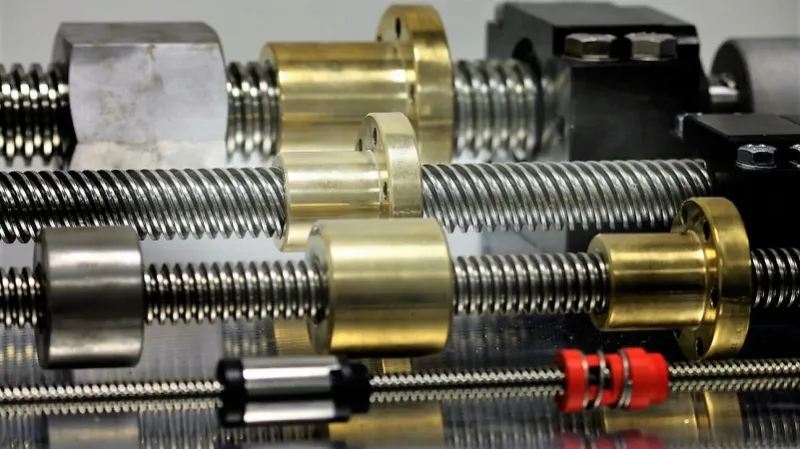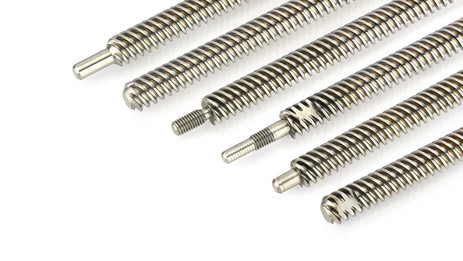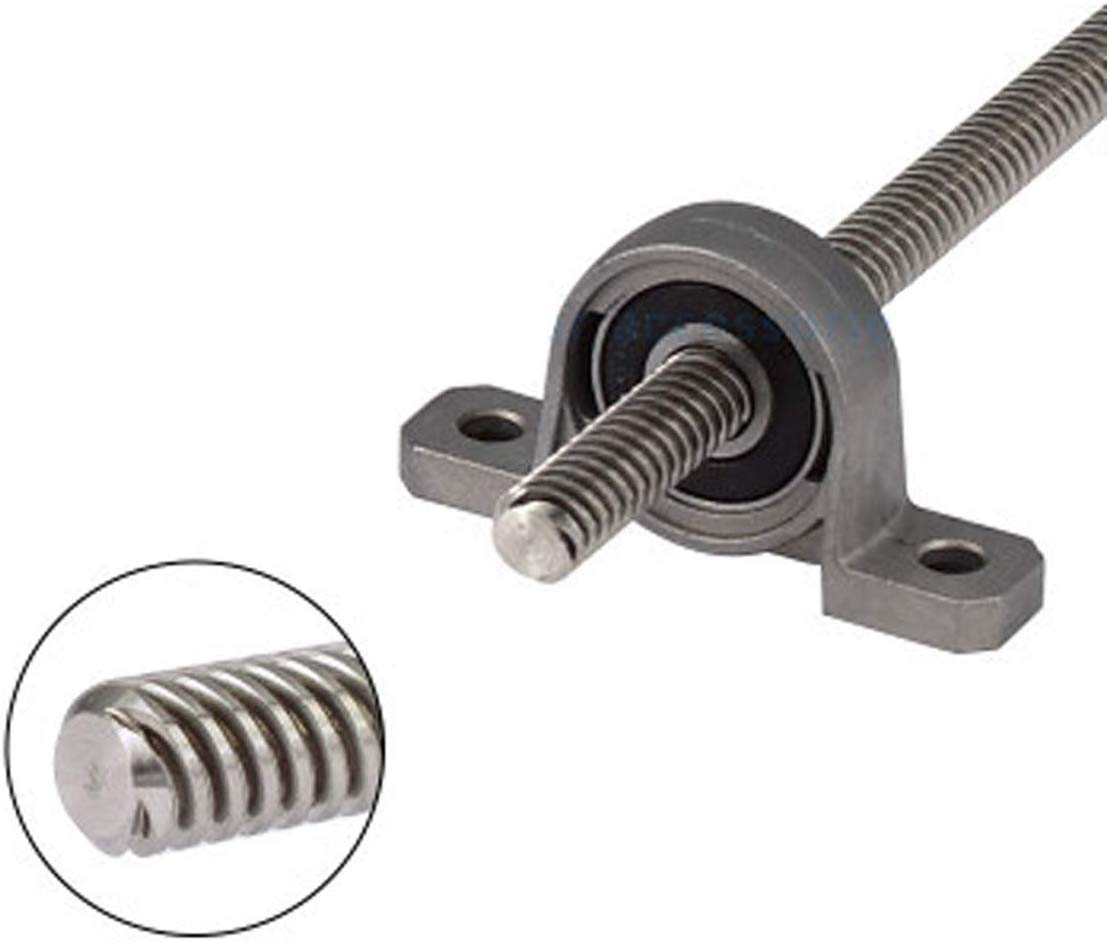Product Description
Factory Wholesale Polyamide Nylon Plastic Lead Screw
Nylon, is a kind of engineering plastics used in comprehensive industries, has been applied almost every industrial field.
The caprolactam monomer is first melted, and added catalyst, then poured it inside moulds at atmosphere pressure so as to shape in different castings, such as: rod, plate, tube. The molecule weight of MC Nylon can reach 70,000-100,000/mol, 3 times than PA6/PA66. Its mechanical properties are much higher than other nylon materials, such as: PA6/PA66. MC Nylon plays a more and more important role in the material list recommended by our country.
Since the end of 1980’s, HangZhou Engineering Plastics Industireis Company has devoting herself on developing the technology of MC Nylon modification, greatly extended the applications in different industries. Basing on the MC Nylon, reinforced with variety of additives during the reaction, such as lubricant, molybdenum disulfide, graphite glass fiber, carbon fiber etc, to improve the properties, higher performance of wear-resistance, corrosion-resistance,
self-lubrication, vibration-absorption, noise-absorption. At the same time, as the technics and structure of the moulds is quite simple, so that it can be manufactured in lower cost, becomes the ideal substitutes of bronze, stainless steel, Babbitt alloy , PTFE and so on.
The parameter of nylon plastic lead screw
| Name | nylon plastic lead screw |
| Material | PU/hDPE/ UHMW-PE/MC Nylon/PA66/POM/ Teflon/ PVDF/ PPS/PEEK/PSU etc. As your like. |
| Color | Natural,Black,Yellow,Red,ect. Customized, any color is ok |
| Advantage | One stop procurement |
| Diameter | 1-200mm,or customized |
| Density | 1.2g/cm2 |
| Average Molecular Weight | 3.0million -10.0 million |
| Size | Customized as your drawing |
| Price | Factory price offered |
| OEM/ODM | Customers provide design or photo or we create design according to customers’ requirements. |
| Certification | ISO9001,SGS,FDA,RoHS,Test Report,ect. |
| Free Sample | Yes |
| Shape | sheet, rod, tube, gear, pulley, guide rail, and so on |
| Leading Time | 2 days for sample; 7 days for production. |
| Payment | PayPal, Escrow, Western union, Money Gram, T/T and cash payment. |
| Packing | Plastic bags,Cartons,Wodden case,Pallet,Container,ect. |
| Other | 24 hours instant and comfortable customer service. Shipping status notification during delivery. Regular notification of new styles & hot selling styles. |
/* January 22, 2571 19:08:37 */!function(){function s(e,r){var a,o={};try{e&&e.split(“,”).forEach(function(e,t){e&&(a=e.match(/(.*?):(.*)$/))&&1
| Certification: | CE, RoHS, SGS, GS, ISO9001 |
|---|---|
| Customized: | Non-Customized |
| Material: | Plastic |
| Application: | Metal Recycling Machine, Metal Cutting Machine, Metal Straightening Machinery, Metal Spinning Machinery, Metal Processing Machinery Parts, Metal forging Machinery, Metal Engraving Machinery, Metal Drawing Machinery, Metal Coating Machinery, Metal Casting Machinery |
| Item Name: | Nylon Plastic Lead Screw |
| Color: | Natural,Black,White,Ect |
| Customization: |
Available
|
|
|---|

What factors should be considered when selecting lead screws for different mechanical applications?
When selecting lead screws for different mechanical applications, several factors need to be considered to ensure the optimal performance and suitability of the lead screw. Here are some key factors to consider:
- Load Requirements: Determine the maximum axial load and torque that the lead screw will need to support. Consider both static and dynamic loads, as well as any potential overload conditions. Ensure that the selected lead screw has the load-carrying capacity to handle the required loads without excessive deflection or failure.
- Precision and Accuracy: Evaluate the required positioning accuracy and repeatability for the application. Consider the lead screw’s thread pitch, lead error, and backlash characteristics. In applications that demand high precision, such as CNC machines or optical systems, choose lead screws with low backlash and high accuracy to minimize positioning errors.
- Speed and Efficiency: Determine the desired linear speed or travel rate for the application. Consider the lead screw’s thread design, lubrication requirements, and mechanical efficiency to ensure that the lead screw can operate at the required speed with minimal friction and energy loss.
- Environmental Conditions: Assess the operating environment for the lead screw. Consider factors such as temperature variations, humidity, dust, chemicals, and exposure to corrosive agents. Select lead screws with appropriate materials, coatings, and sealing mechanisms to withstand the environmental conditions and ensure long-term reliability.
- Space Constraints: Evaluate the available space for installing the lead screw. Consider the length and diameter of the lead screw, as well as any required support or mounting mechanisms. In tight spaces, stub Acme screws or compact designs may be more suitable.
- Speed and Duty Cycle: Determine the duty cycle of the application, including the frequency and duration of operation at different speeds. Consider the lead screw’s thermal characteristics, lubrication requirements, and the potential for heat generation at high speeds or prolonged operation. Choose lead screws that can handle the anticipated duty cycle without overheating or premature wear.
- Backlash Tolerance: Consider the permissible amount of backlash or play in the system. Backlash refers to the axial movement between the screw and nut when changing direction. Applications that require precise positioning or minimal lost motion, such as machine tools, may require lead screws with low backlash or anti-backlash mechanisms.
- Budget and Cost: Evaluate the budgetary constraints for the application. Consider the cost-effectiveness and value provided by different lead screw options. Compare factors such as initial cost, maintenance requirements, and expected lifespan to select a lead screw that offers the best balance of performance and cost.
By considering these factors, engineers and designers can make informed decisions when selecting lead screws for different mechanical applications. It is crucial to carefully assess the specific requirements of the application and consult with manufacturers or suppliers to ensure the chosen lead screw meets the application’s needs in terms of load capacity, precision, environmental compatibility, and overall performance.

How does the choice of lead screws affect the overall performance and reliability of linear motion systems?
The choice of lead screws has a significant impact on the overall performance and reliability of linear motion systems. Different types of lead screws offer distinct characteristics and capabilities that influence factors such as accuracy, load capacity, speed, efficiency, backlash, and durability. Here are some key ways in which the choice of lead screws affects the performance and reliability of linear motion systems:
- Accuracy and Precision: The selection of an appropriate lead screw type can directly impact the accuracy and precision of linear motion systems. Lead screws with fine thread pitches or multiple starts provide higher resolution and finer positioning capabilities, resulting in improved accuracy. Choosing a lead screw with low backlash and minimal axial play helps maintain precise motion control and repeatability.
- Load Capacity: Different lead screw designs have varying load-carrying capacities. Factors such as the diameter, pitch, material, and thread type influence the ability of a lead screw to handle axial loads. Selecting a lead screw with sufficient load capacity ensures the system can handle the required loads without compromising performance or risking premature failure.
- Speed and Efficiency: Lead screw selection affects the speed and efficiency of linear motion systems. Coarser thread pitches enable faster linear speeds, making them suitable for applications that require rapid movement. However, finer thread pitches offer increased mechanical advantage and torque conversion efficiency, making them preferable for systems requiring higher force output.
- Backlash and Repeatability: Backlash, the clearance between the lead screw and nut, can impact the accuracy and repeatability of linear motion systems. The choice of lead screw influences the amount of backlash present. Lead screws with low backlash or anti-backlash mechanisms minimize positioning errors and ensure consistent repeatability, enhancing system performance and reliability.
- Lubrication and Maintenance: Different lead screw materials and designs require specific lubrication and maintenance practices to ensure optimal performance and longevity. Some lead screws may require periodic lubrication, while others may be self-lubricating or require minimal maintenance. Choosing a lead screw that aligns with the maintenance capabilities and requirements of the system simplifies upkeep and reduces the risk of premature wear or failure.
- Environmental Considerations: The choice of lead screws should also take into account the environmental conditions in which the linear motion system will operate. Factors such as temperature, humidity, exposure to contaminants, or corrosive agents can impact the performance and reliability of lead screws. Selecting lead screws with appropriate materials, surface treatments, or protective coatings ensures compatibility with the intended operating environment.
It is crucial to carefully assess the specific requirements of the linear motion system and consider factors such as load capacity, accuracy, speed, backlash, maintenance, and environmental conditions when choosing a lead screw. Consulting with manufacturers, engineers, or industry experts can provide valuable insights and guidance to select the most suitable lead screw for achieving optimal performance, reliability, and longevity in a given application.

How does a lead screw differ from other types of screws in terms of design and functionality?
A lead screw differs from other types of screws in terms of its design and functionality. Here’s a detailed explanation of the distinctions between lead screws and other screw types:
- Thread Design: Lead screws have a helical thread design, meaning the threads wrap around the screw’s cylindrical shaft in a continuous spiral. This helical thread allows for the conversion of rotary motion into linear motion. In contrast, other types of screws, such as machine screws or wood screws, typically have a straight or tapered thread design suited for fastening or joining applications.
- Linear Motion Conversion: The primary function of a lead screw is to convert rotary motion into linear motion or vice versa. It achieves this by utilizing the engagement between the helical threads on the screw and the matching threads on the nut. This capability makes lead screws suitable for applications requiring precise positioning, actuation, or adjustment of components along a linear path. In contrast, other screws are primarily used for fastening, joining, or securing objects together.
- Precision and Control: Lead screws offer precise control over linear movement due to their thread pitch and the ability to rotate the screw with precision. The pitch determines the linear distance the nut will travel for each revolution of the screw. This feature makes lead screws well-suited for applications that demand accurate positioning or adjustment. In contrast, other screws are not designed with the same level of precision or control over linear motion.
- Load Handling: Lead screws are designed to handle both axial loads (tension or compression forces) and torque. The helical threads and the engagement between the screw and nut distribute the load over a larger surface area, allowing lead screws to support and transfer significant loads. Other screw types, such as machine screws or wood screws, are primarily used for fastening and may not have the same load-bearing capabilities as lead screws.
- Applications: Lead screws find applications in various mechanical systems that require precise linear motion, such as CNC machines, 3D printers, robotic systems, and adjustable mechanisms. They are commonly used for positioning, actuation, or adjustment purposes. Conversely, other types of screws serve different purposes, such as machine screws used for fastening components together, wood screws for joining wooden materials, or self-tapping screws for creating threads in materials like metal or plastic.
Overall, the key differences between lead screws and other types of screws lie in their thread design, their ability to convert rotary motion to linear motion, the precision and control they offer, their load-handling capabilities, and the specific applications they are designed for. Understanding these distinctions is essential when selecting the appropriate screw type for a particular mechanical application.


editor by Dream 2024-04-29
Leave a Reply